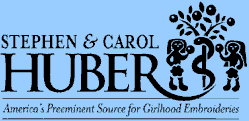|
NEEDLEWORK BY YOUTHFUL HANDS: NOT MADE TO BE SOLD
By Carol Huber
"When young collectors have asked my advice on what to collect, my answer has always been samplers, for I
believe they are still under priced and their importance is generally underestimated. The collecting of samplers,
compared with other fields of collecting, gives you the pleasant advantage of generally knowing where a piece was
made, when it was made, and by whom, because samplers are very often signed and dated," stated Ted Kapnek
in 1978. Collecting samplers has long been a pastime of museums, historical societies and private individuals.
In the world of antique collecting, samplers and silk embroideries are an extremely sophisticated decorative art
form stitched by young girls at school under the tutelage of a needlework instructress. Unlike furniture, paintings,
and accessories, collecting schoolgirl needlework is made even more compelling by the fact that it was never manufactured
or created for sale.
Samplers were originally stitched by young women as a reference for embroidery on clothing, patterns, decorative
ornamentation, and marking of household textiles. As it evolved the making of a sampler taught lettering, design,
pictorial composition and moral values. In the 17th century, American samplers were simply copies of English pieces.
But in the early 18th century the designs began to vary and the American sampler evolved into a freer, flowing,
larger and more pictorial work of art. Recognizable regional differences developed as teachers moved, traded patterns,
and altered designs. It is this group that comprise the interesting pieces that are being collected today and the
excitement stems from recognizing the region, time frame, teacher, and sometimes the student.
An important aspect of identifying American samplers is recognizing the characteristics of regional styles by comparing
elements within the sampler and border design. Here are just a few examples.
The early 18th century Boston band samplers often contain a band referred to as a hexagonal band, wine glass band,
or hour-glass band, found only in this area until the second half of the 18th century where it appeared in Haverhill,
Massachusetts (Fig. 1).
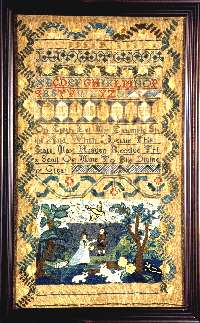
Fig. 1 Sarah Doubt wrought this sampler in the 10 year of her Age 1765. Silk on linen; 19 7/8" x 11
The trefoil band in Sarah Doubt's sampler of 1765 is also seen in the border of many Newburyport samplers including
Molly Colby's piece worked at Ann Water's school in 1785rs from her school often included the trefoil pattern,
a large parrot and owl-topped trees (Fig. 2).
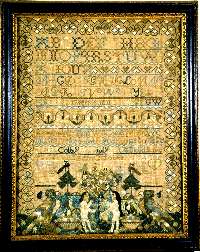
Fig. 2 Molly Colby Born july 20 1768 did/ This (?) (?) in October 12 1785/ A.W. Silk on linen; 21 ½"
x 16 ¾". Newburyport, Massachusetts. The trefoil border is typical of the Newbury and Newburyport area
and the parrot is often found on samplers from Ann Waters school where Molly worked her piece.
In Middlesex County, Massachusetts, a large group of related samplers are framed with a wide arcaded border of
open square boxes with floral insets. Many feature a central house and a strawberry cartouche at the bottom (Fig.
3).
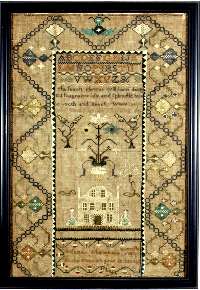
Fig. 3 Susanna Whittemores work wrought/ in the Eleventh year of her age. Silk on linen; 22 3/8" x 15 3/8".
Middlesex County, Massachusetts. The deep arcaded border comprised of little squares and flower designs are prevalent
in this group. A central house within a saw-tooth border and strawberry-bordered cartouche are also common.
Linsey-woolsey ground fabrics (linen warp and wool weft) in dark colors are often indicative of pieces worked in
Portsmouth, New Hampshire or Salem, Massachusetts. Identifying characteristics of one group from Salem are the
large cornucopias in the lower corners holding a floral vine that moves upward on each side flanking a large pot
of flowers (Fig. 4).
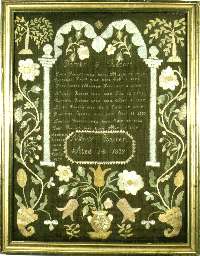
Fig. 4 Nancy Batten Aged 14 1809. Silk on green linsey-woolsey; 25 7/8" x 19 ¾". Salem, Massachusetts.
Several examples exist from this unidentified school. Large cornucopias in the lower corners are employed with
wandering vine borders and large flower pots. (Ex-collection Joan Stephens).
Norwich, Connecticut pieces often employed a Greek key design found in both borders and bands and an elongated
tulip band sometimes accompanies them stitched giving the appearance of linsey-woolsey (Fig. 5).
.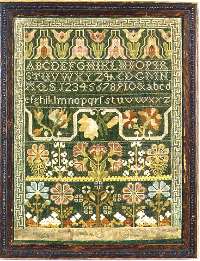
Fig. 5 Unsigned sampler with an Ayer's family provenance. Silk on linen; 15 ¼" x
11 ½". Norwich, Connecticut. Characteristic of this school, the background is completely
Filled background areas are common in this region, including samplers from Franklin, Connecticut made at Rev.
Samuel Nott's school which have compartmentalized borders (Fig. 6).
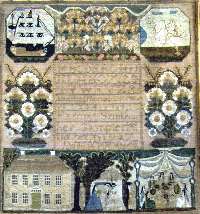
Fig. 6 Fanny Smith/ her sampler A/ ug 23 AD 1797/ in the 14th year of her age. Silk on linen; 17" x 16
¼". One of five known examples from the Rev. Samuel Nott's school in Franklin, Connecticut. Several
of the border compartments have solidly stitched backgrounds
The whimsical samplers of the Canterbury, New Hampshire area are easily identified by the rolling hillock bottom
band filled with stylized flowers, tiered trees, baskets, birds, and a double-leaf moustache above, all outlined
in black creating a very bright and bold effect. These pieces usually contain a large saw-tooth border setting
off the text and a large strawberry band separating the alphabets (Fig. 7).
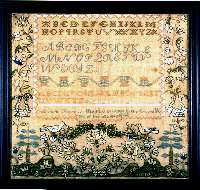
Fig. 7 Abigail French's Sampler wrought in the Seventeenth/ year of her age A x d 1822. Silk on linen; 16 3/8"
x 17 1/8".Samplers from the Canterbury, New Hampshire area have flowers, birds and hillocks outlined in black.
The inner saw-tooth border and large strawberry band are also characteristic.
Aside from regional preferences, sampler collectors define their collections in many other ways. Betty Ring, noted
sampler historian, has a collection that stands as one of the best in the country (illustrated in her book, American
Needlework Treasures). It is comprised of samplers and silk embroideries from many different areas worked under
the instruction of some of the most prominent teachers of the 18th and 19th centuries. It is outstanding in quality
and content. Her constant word of advice to upcoming collectors is to, "Collect the best you can, look for
quality not quantity".
Two important sampler auctions in recent years; the Ted Kapnek sale in 1981, and the Joan Stephens sale in 1997
(both at Sotheby's), forever changed the status of American girlhood embroidery in the marketplace. These sales
caught the attention of antique collectors across the country giving the field substance and securing the prices
for future sales. These auctions helped to elevate these graphic and beautiful samplers and silk embroideries to
their rightful place as works of art to be hung in the "best parlour" a place of honor, which was their
original designated hanging place.
Extensive research accomplished in the 20th century has added a depth of knowledge to the field. The first major
work ever published on the subject, American Samplers, by Ethel Stanwood Bolton and Eva Johnston Coe, records over
2,500 samplers. Glee Krueger's, New England Samplers to 1840, explains techniques and style, and lists teachers
by date and state. Her book, A Gallery of American Samplers, catalog for the Ted Kapnek collection exhibition,
includes additional research and stunning color photographs. Mary Jaene Edmonds provides interesting research of
her collection in Samplers and Samplermakers.
Scholar and historian, Betty Ring, in her renowned Girlhood Embroidery, is responsible for the most ambitious research
undertaken in the 20th century, in the field of schoolgirl needlework. This large, two-volume set gives extensive
in-depth information on styles, regional characteristics, and background information on schools and teachers. Her
first book, Let Virtue Be A Guide To Thee, written as the catalog for the Rhode Island Historical Society exhibition
on Rhode Island samplers was a $19.95 paperback. Difficult to find it now sells for $800.00 and up, an interesting
comment on the enthusiasm of sampler collectors.
Currently many outstanding private collections are being assembled with new pieces continually surfacing. Some
collectors focus on region, others a specific period, some family names, and many collect samplers related to one
type of design. Many clients are looking for just one or two great pieces, others are building collections with
only the cream of the crop. The common denominator is the excitement and enthusiasm that comes with the discovery
and research of a new piece and finding related examples. There are hundreds of samplers available and the market
is strong for selling, buying, or upgrading. Wonderful examples are available for less than three thousand dollars
while extraordinary works can sell for tens of thousands. Visual appeal and condition are the most important factors
to look for when acquiring and determining price.
Samplers and silk embroideries, collected now as works of art, have left a legacy to the women who designed and
the girls who stitched these engaging American needleworks.
These gracious young girls would be pleased to know their hard work is still cherished.
"This work perhaps my friends may have
When I an in my silent grave
And which when ere they chance to see
May kind remembrance picture me
While on the glowing canvas stands
The labour of my youthfull hands
No other cares that this I know
But perseverence brought me through"
Hannah Francis 1817, Pennsylvania
"This needlework of mine doth tell
When I was young I learned well:
Though by elders I was taught
Not to spend my time for naught."
Sally Wales Turner circa 1800, Massachusetts
Stephen and Carol Huber have specialized exclusively in samplers, silk embroideries and canvaswork pictures
for the past twenty-two years. They are internationally known authorities on the subject and have been instrumental
in creating the marketplace for girlhood embroideries through lectures, teaching, research, articles, antique shows
and their 18th century gallery (open by appointment) in Old Saybrook, Connecticut. They can be reached at 860-388-6809
click for more articles about antique needlework
STEPHEN & CAROL HUBER
(860) 388-6809
|

